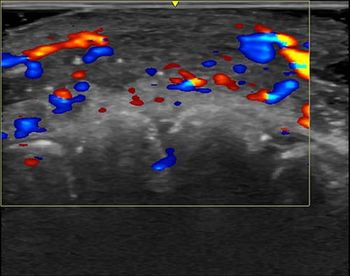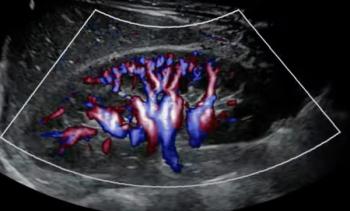
Ultrasound could provide early diagnosis of respiratory distress syndrome
Lung ultrasound exams reliably detect respiratory distress syndrome in premature neonates and could be used as a radiation-free method for diagnosis and guidance for treatment.
Lung ultrasound exams reliably detect respiratory distress syndrome in premature neonates and could be used as a radiation-free method for diagnosis and guidance for treatment.
Respiratory distress syndrome occurs primarily in premature infants whose lungs haven't matured enough to produce surfactant, which keeps lung tissues from sticking together. Early treatment is usually the most beneficial.
Clinical indications such as low blood oxygen levels and shallow breathing provide clues, but the current standard diagnostic test for respiratory distress syndrome is chest x-ray. Previous studies have examined ultrasound's diagnostic value, but they used a transabdominal cross-section through the liver and spleen.
Dr. Roberto Copetti and colleagues at hospitals in Tolmezza and Udine, Italy, examined 55 preterm newborns, 40 with clinical and radiological signs of respiratory distress syndrome. The other 15 infants did not have respiratory distress syndrome, but some had other respiratory problems. The researchers published their paper in Neonatology, which made it available online Jan. 15.
All infants were examined clinically and given chest x-ray and ultrasound exams within the first 24 hours after they were born. Some were examined within the first hour after birth. The researchers used a transthoracic approach to get a more complete look at the lungs.
The 40 infants with respiratory distress syndrome had a mean gestational age of 27.2 weeks and a mean birth weight of 1057 g. Their ultrasound exams consistently showed echographic "white lung," or generalized alveolar-interstitial syndrome. They also showed pleural line anomalies such as small subpleural consolidations, thickening, or irregularity or a coarse appearance. No part of these patients' lungs was free of anomalies.
Exams from the other 15 premature infants showed portions of alveolar-interstitial syndrome but also showed areas of the lungs free of any ultrasound anomalies.
The researchers concluded that respiratory distress syndrome has a specific ultrasound appearance. The pleural line anomalies presented simultaneously with white lung identified respiratory distress syndrome with a sensitivity and specificity of 100%.
They also noticed changes to the lungs of respiratory distress syndrome patients after treatment began and so suggest that ultrasound could be used to monitor disease progression with multiple exams in ways x-rays can't because of radiation exposure.
Newsletter
Stay at the forefront of radiology with the Diagnostic Imaging newsletter, delivering the latest news, clinical insights, and imaging advancements for today’s radiologists.




























